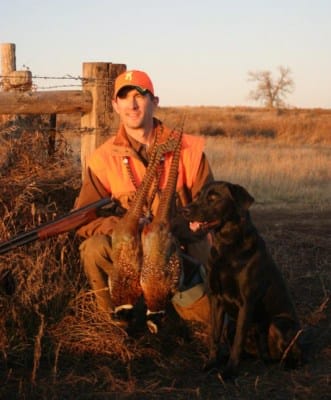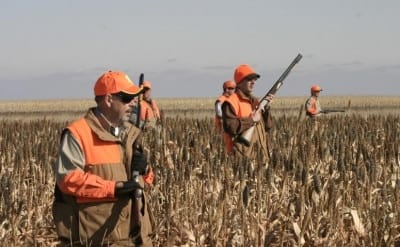
For all the attention and concern given non-native species – think snakeheads, zebra mussels, released pythons, and even wild European boars – that are showing they can thrive in America’s wild lands and waters, one species you can bet will never raise the ire of American wildlife biologists and sportsmen is the ring-necked pheasant.
The first attempts at releasing pheasants, a traditional game bird hunted primarily by the upper classes of Europe, in the new world took place in 1733 in New York, when several pairs of black-necked pheasants were released, according to the U.S. Geological Survey. Naturally, that attempt to establish the species, in what were then colonies, failed, as did subsequent attempts in New Hampshire and New Jersey in the early 1800s. It wasn’t until Judge Owen Nickerson Denny, who was serving as the United States consul to China, had 30 Chinese ring-necks shipped to his home in Willamette Valley, Ore., in 1881 that a true population of birds became established. Just 11 years later, according to Pheasants Forever, the state opened a 75-day season in which some 50,000 pheasants were bagged!
Today, pheasants rank among one of the most popular gamebirds hunted in North America, with wild populations found in nearly every part of the country except for the Southeast and extreme Southwest, and even in those areas game farm birds can still likely be hunted. The bird’s popularity has even spawned numerous festivals and of course, a dedicated conservation group in Pheasants Forever. But nowhere is the ring-necked pheasant king more than in South Dakota, where hunters take more than a million birds each year. According to South Dakota Game, Fish & Parks, only twice in the past 20 years, in 1992 and 1997, has the harvest dropped beneath the million mark and even then it was still above 900,000, far more than any other state.

The Heart of Pheasant Country
While there are plenty of states across the Midwest that have abundant pheasant hunting opportunities, to experience the true promise of a full-range ring-neck adventure, nowhere delivers like South Dakota. There hunters will find everything from large-scale, high-end lodges, such as Prairie Sky Guest and Game Ranch (www.prairieskyranch.com) in Veblen, designed to cater to both small and large hunting parties, including corporate outings, with a mix of both wild and release birds to purely wild hunts that offer a sportsman the best opportunity to experience pheasant hunting as it was enjoyed during the bird’s heyday of the mid-1900s. In South Dakota, pheasant hunting is big business.
“In South Dakota, residents really recognize the economic impact hunters bring to their state,” says Bob St. Pierre, vice president of marketing at Pheasants Forever (www.pheasantsforever.org). “It’s a real treat to go someplace in this day and age where blaze orange is still welcomed.
“Residents are very friendly to hunters. They cater to hunters’ needs. Gas stations sell shotgun shells and hunting gear, signs at hotels and restaurants welcome sportsmen to the area. It’s a big deal to them and really a great marriage between hunters and residents.”
Going Native
To experience South Dakota hunting as it is told by our grandfathers, few places boast the out-of-state hunter a wild bird hunting experience like South Dakota Wild (www.southdakotawild.com), a 20-year-old business that leases farms that are managed like farms where in the 1950s with ample cover and habitat for wild populations of ring-necks to flourish.
“We encourage the hunters we work with to keep the land as natural as it was back in the 50s,” says Jill Langer, who originally started the business with her father. “We work with them to keep shelterbelts intact, as well as provide plenty of CRP and water areas. We manage a whole generation of farms in order to provide hunters with the best wild bird hunting experience they can find.”
South Dakota Wild typically offers three-day hunts where hunters can even pick from one of the 13 farms the company manages if they know what they are looking for. Some of the properties offer rural accommodations such as a farm house, where sportsmen can prepare their own meals each day and make themselves at home. On other properties, the service coordinates lodging with nearby hotels that cater to hunters by providing kennel facilities or allowing dogs to stay in rooms as well as bird cleaning facilities or services. Hunts run from mid-October through the first of the year.
The size of farms South Dakota Wild manages varies from a 640-acre farm for two people to hunt, to properties that boast nearly 10,000 acres and can handle large hunting parties. The cost of hunts runs between $495 and $695 depending on when a hunt is scheduled. Langer admits it’s not the easier hunt offered by released-bird operations.
“You work for your birds, but most of my guys shoot their limits,” she says. “It’s nothing to kick up 20 to 30 birds a day.”
And while it seems most hunters want to hunt the first two weeks to get the jump on unwary birds, Langer hints that the best time to experience the state is in mid-November through December. By then there is usually snow on the ground, which tends to clump birds together, there is less hunting pressure to compete with, and the crops are cut making it easier to navigate fields and locate birds.
“If you want to shoot release birds you can do that anywhere, if you want to really hunt like South Dakota was intended to be hunted, this is the place to experience that,” Langer says.
More Top Destinations
If South Dakota is too far from home, or maybe you’ve hunted there already and want a change of pace. There are other states taht offer good pheasant hunting, too. Thanks to Pheasants Forever for providing the following forecast information.

Kansas: 746,000 rooster harvest in 2009; dubbed South Dakota South by Pheasants Forever.
Minnesota: 400,000+ rooster harvest in 2009; despite a rough 2009 winter, it should be another good year.
Iowa: 271,136 rooster harvest in 2009; last year was a record low harvest and this year is expected to be worse, but Iowa still offers better hunting than many other places.
North Dakota: 650,000 rooster harvest in 2009; the southwest corner of the state, followed by the northwest corner, offers the best hunting.
Wisconsin: 41,800 rooster harvest in 2009; numbers are down for third consecutive year, but top counties remain Lafayette, Polk, Fon du Lac, Pierce and Jefferson.
Nebraska: 300,000+ rooster harvest in 2009; southwest and sandhills regions of the state are tops with this year’s survey showing healthy jumps.
Note: Photos courtesy of Brian Lynn.



